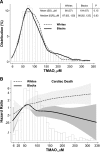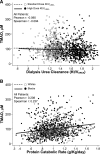Trimethylamine N-Oxide and Cardiovascular Events in Hemodialysis Patients
- PMID: 27436853
- PMCID: PMC5198291
- DOI: 10.1681/ASN.2016030374
Trimethylamine N-Oxide and Cardiovascular Events in Hemodialysis Patients
Abstract
Cardiovascular disease causes over 50% of the deaths in dialysis patients, and the risk of death is higher in white than in black patients. The underlying mechanisms for these findings are unknown. We determined the association of the proatherogenic metabolite trimethylamine N-oxide (TMAO) with cardiovascular outcomes in hemodialysis patients and assessed whether this association differs by race. We measured TMAO in stored serum samples obtained 3-6 months after randomization from a total of 1232 white and black patients of the Hemodialysis Study, and analyzed the association of TMAO with cardiovascular outcomes using Cox models adjusted for potential confounders (demographics, clinical characteristics, comorbidities, albumin, and residual kidney function). Mean age of the patients was 58 years; 35% of patients were white. TMAO concentration did not differ between whites and blacks. In whites, 2-fold higher TMAO associated with higher risk (hazard ratio [95% confidence interval]) of cardiac death (1.45 [1.24 to 1.69]), sudden cardiac death [1.70 (1.34 to 2.15)], first cardiovascular event (1.15 [1.01 to 1.32]), and any-cause death (1.22 [1.09 to 1.36]). In blacks, the association was nonlinear and significant only for cardiac death among patients with TMAO concentrations below the median (1.58 [1.03 to 2.44]). Compared with blacks in the same quintile, whites in the highest quintile for TMAO (≥135 μM) had a 4-fold higher risk of cardiac or sudden cardiac death and a 2-fold higher risk of any-cause death. We conclude that TMAO concentration associates with cardiovascular events in hemodialysis patients but the effects differ by race.
Keywords: cardiovascular events; epidemiology and outcomes; hemodialysis.
Copyright © 2016 by the American Society of Nephrology.
Figures


Similar articles
-
Association of trimethylamine N-Oxide with cardiovascular and all-cause mortality in hemodialysis patients.Ren Fail. 2020 Nov;42(1):1004-1014. doi: 10.1080/0886022X.2020.1822868. Ren Fail. 2020. PMID: 32985309 Free PMC article.
-
Trimethylamine N-Oxide and Cardiovascular Outcomes in Patients with ESKD Receiving Maintenance Hemodialysis.Clin J Am Soc Nephrol. 2019 Feb 7;14(2):261-267. doi: 10.2215/CJN.06190518. Epub 2019 Jan 21. Clin J Am Soc Nephrol. 2019. PMID: 30665924 Free PMC article.
-
Associations of Trimethylamine N-Oxide With Nutritional and Inflammatory Biomarkers and Cardiovascular Outcomes in Patients New to Dialysis.J Ren Nutr. 2015 Jul;25(4):351-6. doi: 10.1053/j.jrn.2015.02.006. Epub 2015 Mar 19. J Ren Nutr. 2015. PMID: 25802017 Free PMC article.
-
Gut microbiota-derived trimethylamine N-oxide is associated with the risk of all-cause and cardiovascular mortality in patients with chronic kidney disease: a systematic review and dose-response meta-analysis.Ann Med. 2023 Dec;55(1):2215542. doi: 10.1080/07853890.2023.2215542. Ann Med. 2023. PMID: 37246850 Free PMC article.
-
Circulating trimethylamine N-oxide and the risk of cardiovascular diseases: a systematic review and meta-analysis of 11 prospective cohort studies.J Cell Mol Med. 2018 Jan;22(1):185-194. doi: 10.1111/jcmm.13307. Epub 2017 Aug 7. J Cell Mol Med. 2018. PMID: 28782886 Free PMC article.
Cited by
-
An overview of renal metabolomics.Kidney Int. 2017 Jan;91(1):61-69. doi: 10.1016/j.kint.2016.08.021. Epub 2016 Sep 28. Kidney Int. 2017. PMID: 27692817 Free PMC article. Review.
-
The human microbiota is associated with cardiometabolic risk across the epidemiologic transition.PLoS One. 2019 Jul 24;14(7):e0215262. doi: 10.1371/journal.pone.0215262. eCollection 2019. PLoS One. 2019. PMID: 31339887 Free PMC article.
-
Ventricular arrhythmias in mouse models of diabetic kidney disease.Sci Rep. 2021 Oct 18;11(1):20570. doi: 10.1038/s41598-021-99891-9. Sci Rep. 2021. PMID: 34663875 Free PMC article.
-
Effects of choline metabolite-trimethylamine N-oxide on immunometabolism in inflammatory bowel disease.Front Immunol. 2025 Jul 17;16:1591151. doi: 10.3389/fimmu.2025.1591151. eCollection 2025. Front Immunol. 2025. PMID: 40746564 Free PMC article. Review.
-
The Microbiome and Uremic Solutes.Toxins (Basel). 2022 Mar 30;14(4):245. doi: 10.3390/toxins14040245. Toxins (Basel). 2022. PMID: 35448854 Free PMC article. Review.
References
-
- United States Renal Data System : 2015 USRDS annual data report: Epidemiology of kidney disease in the United States, Bethesda, MD, National Institutes of Health, National Institute of Diabetes and Digestive and Kidney Diseases, 2015
-
- Foley RN, Parfrey PS, Sarnak MJ: Epidemiology of cardiovascular disease in chronic renal disease. J Am Soc Nephrol 9[Suppl]: S16–S23, 1998 - PubMed
-
- Himmelfarb J, Ikizler TA: Hemodialysis. N Engl J Med 363: 1833–1845, 2010 - PubMed
-
- Longenecker JC, Coresh J, Powe NR, Levey AS, Fink NE, Martin A, Klag MJ: Traditional cardiovascular disease risk factors in dialysis patients compared with the general population: the CHOICE Study. J Am Soc Nephrol 13: 1918–1927, 2002 - PubMed
Publication types
MeSH terms
Substances
Grants and funding
LinkOut - more resources
Full Text Sources
Other Literature Sources
Medical
Molecular Biology Databases

